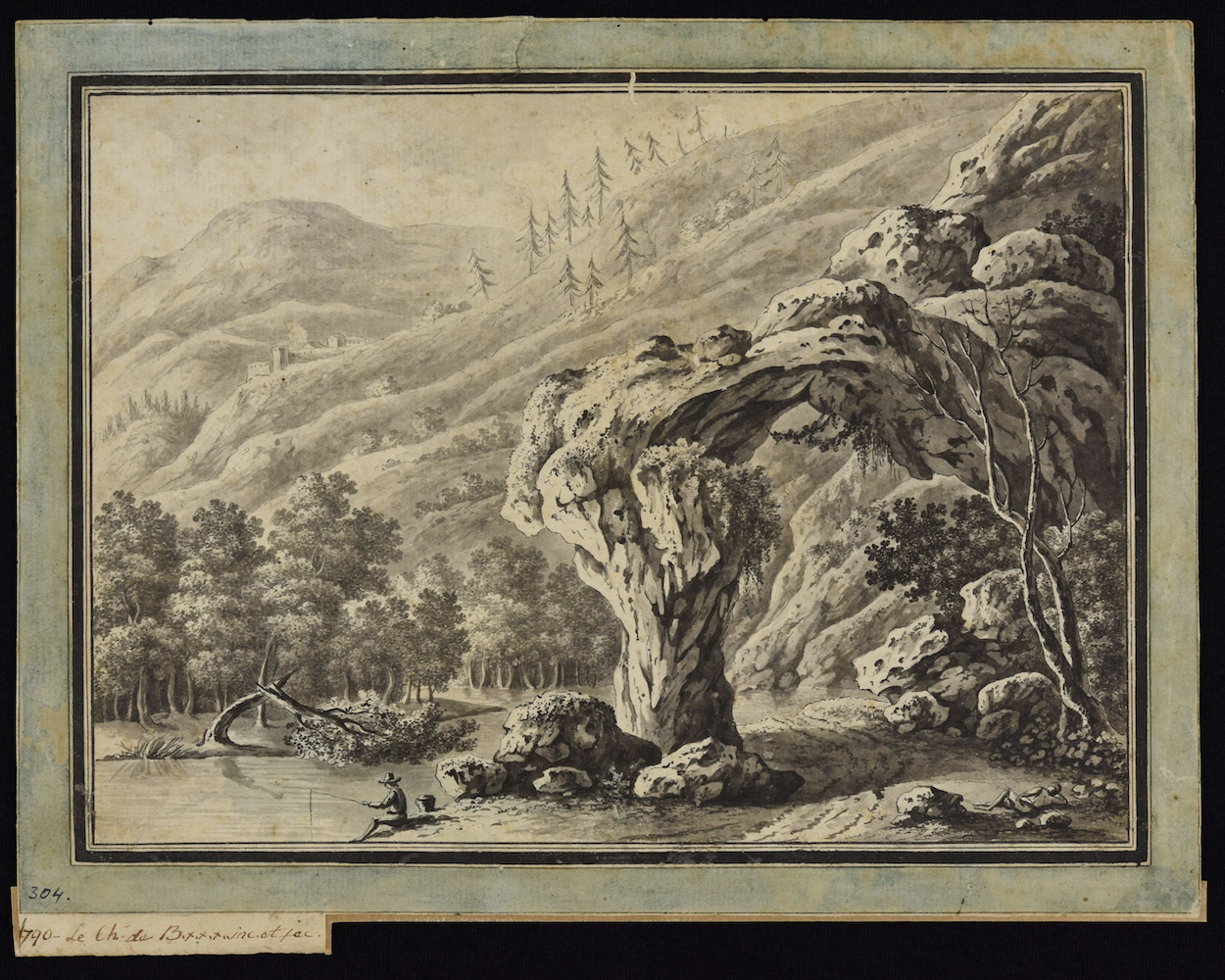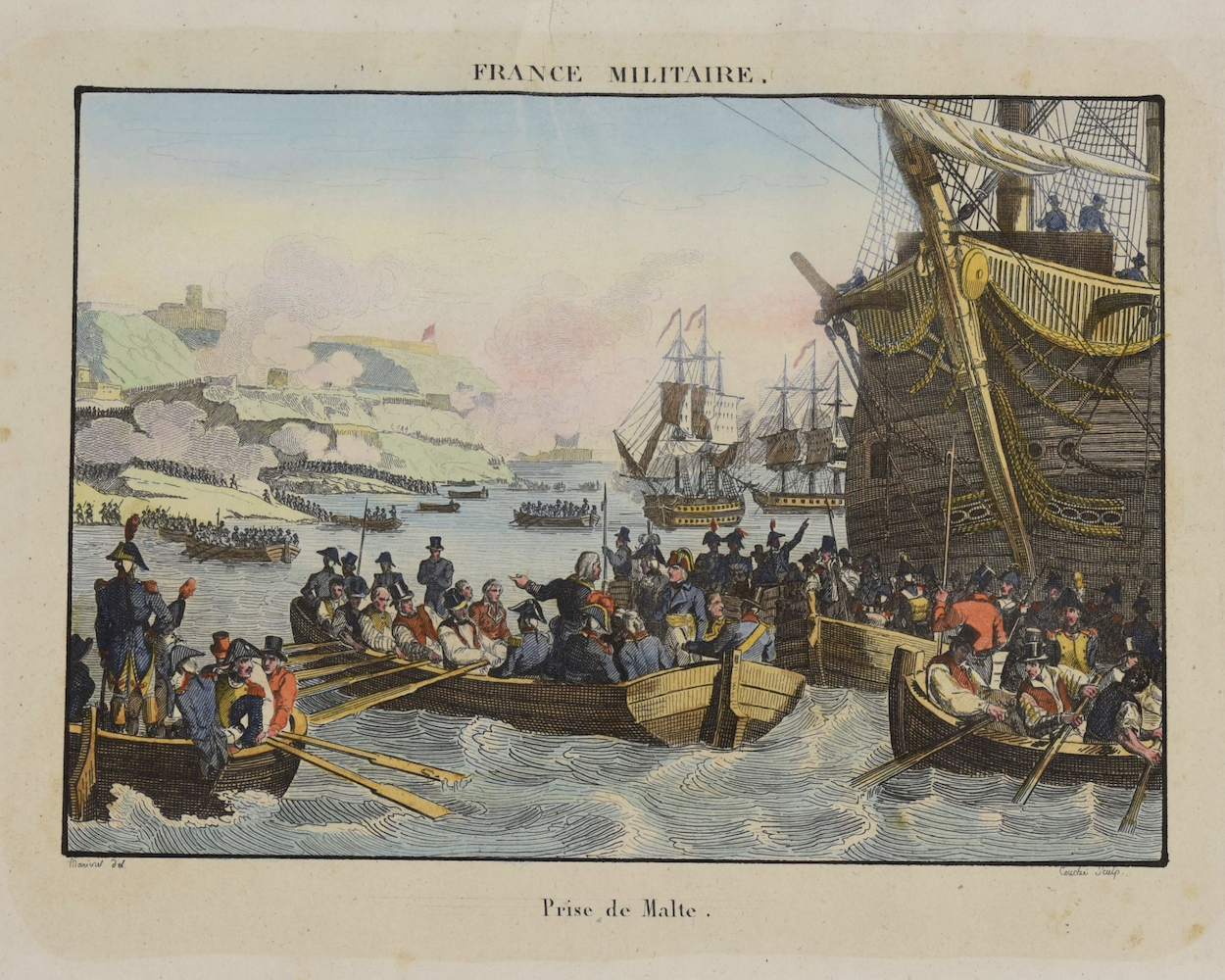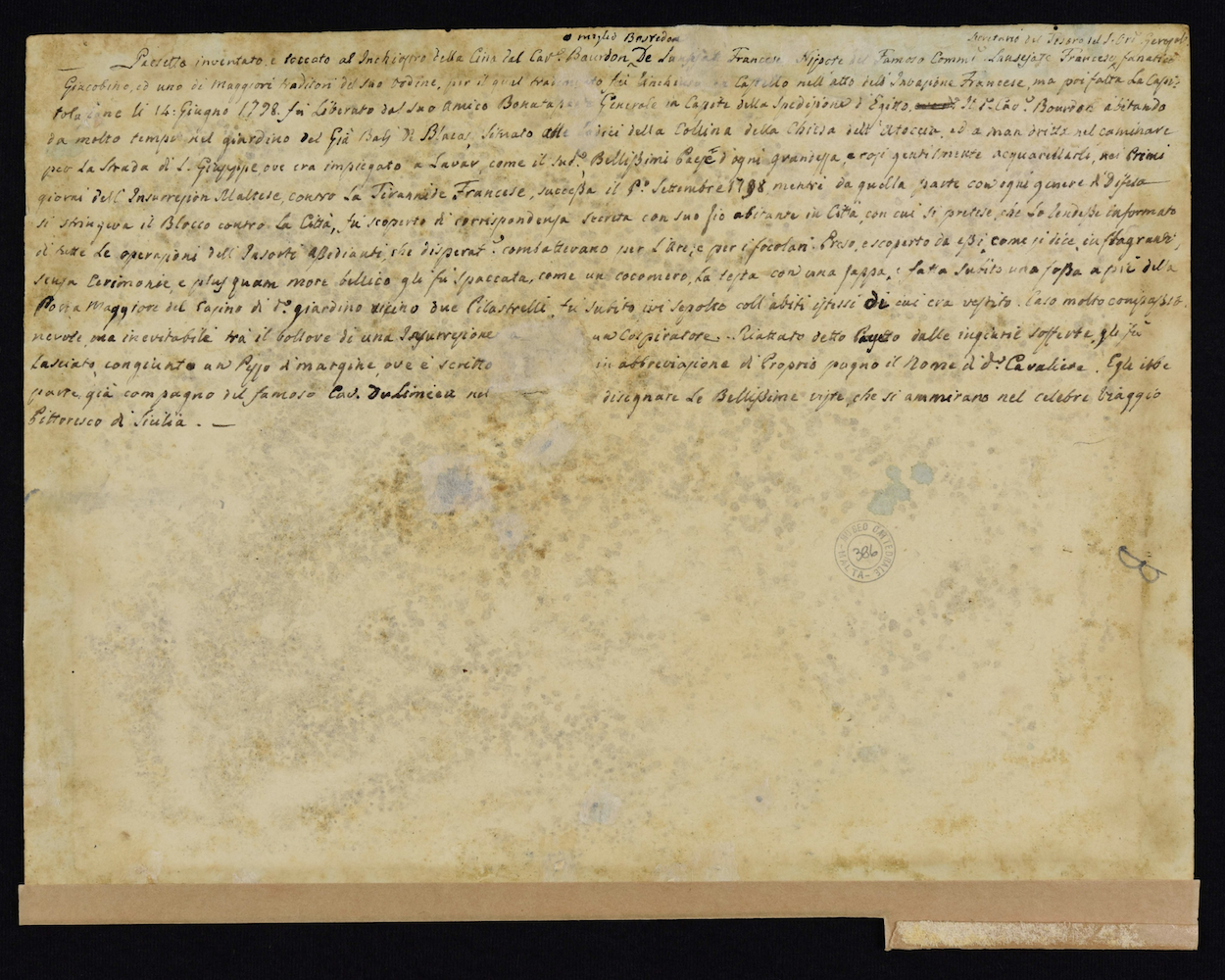Impressions Of A Death Foretold: The Execution Of Fra Sylvain De Bosredon
Impressions of a Death Foretold: the Execution of Fra Sylvain de Bosredon
This story is part of an ongoing series of editorials in which HMML curators and catalogers examine how specific themes appear across HMML’s digital collections. Examining the theme of “Death & Mourning,” Dr. Daniel K. Gullo shares this story from the Malta collection.
In the days before they were going to kill him, Fra Sylvain de Bosredon woke up early in the morning to the dull sound of musket fire coming from the distant walled town of Mdina. For the professed Knight of the Order of Saint John of Jerusalem, the sounds were part of the martial drama that had shaken Malta in the summer of 1798. These were not the idyllic, pastoral Mediterranean scenes that Fra Sylvain had been accustomed to illustrate since his arrival in Malta in the 1770s. They were the sounds of war emanating from the proscenium of Mdina’s bastions, where the tricolored banner of revolutionary France had flown over the Maltese countryside since General Napoleon Bonaparte arrived in the Grand Harbor in June.
Fra Sylvain de Bosredon descended from a venerable French noble family. He was born on September 15, 1756, to François de Bosredon, seigneur de Baubière, and Marie-Anne de Chauvigny de Blot, daughter of Baron Gilbert de Chauvigny de Blot. Like many second sons, he joined the Order of Saint John of Jerusalem to make his career and solidify the relationship between the noble family and the Order of Saint John, which at that point had extended over several generations.
Fra Sylvain was received in the Order as a knight on December 23, 1778, as part of a group of five other young French nobles who also professed as members of the Langue of Auvergne before Christmas day (listed in PFL 00035). He joined several cousins and family members who were already Hospitallers in the Langue of Auvergne, including Fra Jean Marie Bosredon de Vatanges, Fra François Louis de Bosredon, Fra Jean de Bosredon du Poirier, Fra Joseph Bosredon de Manoux, Fra Jean François Magdelaine de Bosredon de Vilvoisin, and the infamous Fra Jean de Bosredon de Ransijat—who would play an indirect role in the murder of his cousin.

Fra Sylvain de Bosredon was a gentleman Hospitaller who reflected the scientific and cultural milieu of the Enlightenment found in the salons and courts of Paris in the 18th century. He was trained as an artist and practiced in administration, being well-versed in the statutory law of the Order as procurator of the provincial Auvergne chapter.
He used his wealth and position in the Order to travel in Calabria, Lipari, and Sicily in the 1780s with his friend and fellow knight, Fra Déodat Gratat de Dolomieu. Fra Déodat was a noted mineralogist, scientist, and geographer who had professed, as a minor, to the Order of Saint John and was made a commander in the Order in 1780. During their tour, Fra Sylvain captured the landscapes of Sicily and Calabria while helping his friend research the geography and history of Italy. His drawings were noticed by other contemporary artists and writers. Jean Claude Richard de Saint-Non used Fra Sylvain’s works when publishing his monumental multi-volume Voyage pittoresque ou description des royaumes de Naples et de Sicile (1781–1786).
The desire to practice his art while serving the administration of the Order led Fra Sylvain in 1790 to rent the country manor Casa Blacas, which had a large Mediterranean garden and orchard a few miles outside of Valletta, Malta. Here he could continue his work, as seen in an untitled landscape finished in 1790, digitized in Mdina at the Cathedral Museum by the Malta Study Center in 2020 (CMUS 00241).

Fra Sylvain’s landscape reflected a combination of the late Baroque styles with an emerging realism of the French School: landscape painting was to be inspired by nature, as much as painted from nature. The artist could rely on imaginative elements to tell a story that was inspired by real places. In CMUS 00241, Fra Sylvain portrays transformed the Auvergnes countryside of his youth into an idyllic pastoral setting.
The pastoral retreat of Casa Blacas was disrupted in the summer of 1798. In June, General Napoleon Bonaparte landed French republican forces in Malta (seen in HMZA 00415) to secure the port prior to his invasion of Egypt. Within days, the Order of Saint John surrendered the island, with most of the knights abandoning Malta along with Grand Master Ferdinand von Hompesch. Some knights remained, either as elderly pensioners or supporters of the new government.

A central figure in the enterprise was the former treasurer of the Order of Saint John, Fra Jean de Bosredon de Ransijat—the uncle of Fra Sylvain. As President of the newly formed French Commission in Malta, Bosredon de Ransijat needed to secure finances to support Napoleon’s republican government in Malta.
With General Claude Henri Vaubois, Bosredon de Ransijat sent missions to gather the valuables, silver, and gold from the monasteries and churches closed by the government in the first days of the French occupation (see NAXR 00238). Such actions violated the terms of surrender when extended to local parish churches, betraying the promise of the new government. This forced-sale of parish and diocesan property excited the Maltese to rebellion on September 2, 1798. On September 3, the Maltese stormed the gates of Mdina and secured the city from the French garrison, taking down the French tricolor and hosting the red and white Maltese flag over the bastions of Mdina.

Mdina’s rebellion encouraged disgruntled Maltese to form ad hoc companies in the countryside looking to punish French collaborators. Several Maltese identified Fra Sylvain as a traitor and collaborator with the new French government. He was a known friend of Fra Déodat Gratet de Dolomieu, who had abandoned the Order during the French Revolution and later accompanied Napoleon on his invasion of Malta as the chief scientist and geographer during the Egyptian campaign. While in Malta, Dolomeiu tried to convince his friend Fra Sylvain to join him in Egypt and serve as an artist depicting Egyptian monuments, just as the two had done in Italy a decade earlier. Fra Sylvain initially accepted, but in the end refused to go due to health issues. He remained in Malta under the new French Republican government administered by his uncle, President Jean de Bosredon de Ransijat.

On the morning of September 4, one day after the liberation of Mdina, the Maltese insurrectionists encountered Fra Sylvain at the villa of Casa Blaca. They accused Fra Sylvain of sending information to his uncle about the movements of the Maltese and their activities against the French. Under the punishing morning Mediterranean sun, the revolutionaries executed the knight and buried him under a tree in the villa’s courtyard. The act was ignominious and violent, typical of the extrajudicial justice that can accompany a rebellion. Its tragedy was recorded by Count Saverio Marchese some years later on the verso side of the idyllic landscape drawing completed by Fra Sylvain in Malta eight years before his death (CMUS 00241). With both realism and imagination, Count Marchese recorded the details of Fra Sylvain’s life and execution, foretold in the musket shots from the bastions of Mdina days before his death:
“The said knight Bourdon [Bosredon] lived a long time in the garden of Balí Blacas situated at the foot of the hill of the church of Atocia and opening on the Saint Joseph Road, where he passed his time drawing lovely and beautifully colored landscapes of all sizes like this one. In the first days of of the Maltese insurrection against the French tyranny, on 4 September 1798, while in that area all measures were being taken to blockade the city [Valletta], he was discovered to be in secret contact with his uncle, who was in the city, feeding him information on all the activities of the insurgents, who were desperately fighting for God and country. Taken thus in the act, his skull was cleft in two with a mattock like a melon without any ceremony and more according to the usage of war, and was immediately buried in the clothes he was wearing in a shallow grave at the main door of the villa of the garden near the two columns. A very sad but inevitable occurrence during the furor of the insurrection against the conspirator.”
—Count Saverio Marchese. From Carmel Testa’s The French in Malta, 1798–1800 (Malta: Midsea Books Limited, 1997), pages 271, 278.




